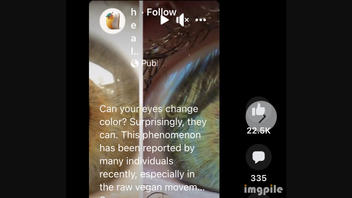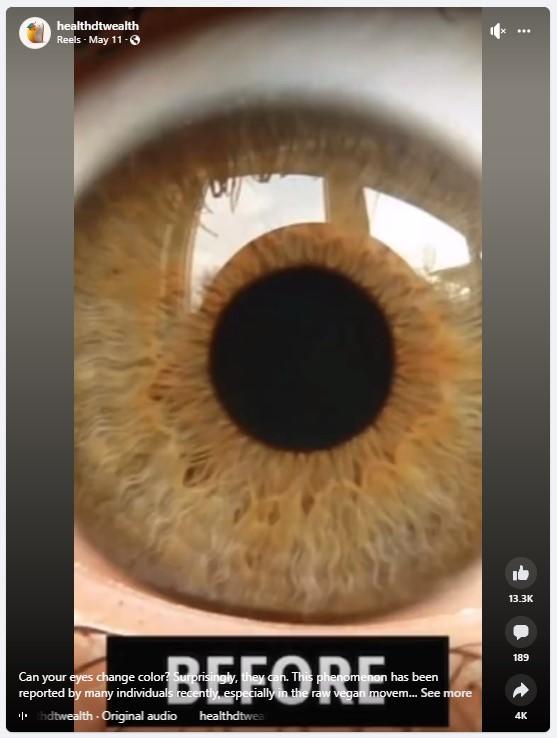
Do the blue eyes of babies turn brown because of carbon -- and can adult eye color tinted by heavy metals, toxins and diseases be changed by "detoxing" -- by adopting a raw fruit-based vegan diet or using herbs such as contribo? No, that's not true: The color of human eyes is determined by several different genes that affect the amount of melanin produced by the melanocytes in the iris. Changes in the amount of melanin can cause the eyes to become darker or lighter. Eye color is not caused by unspecified toxins or changed by scientifically unproven efforts to "detoxify" the body.
The reel making this claim was posted on Facebook by the page healthdtweath on May 11, 2023. It was captioned:
Can your eyes change color? Surprisingly, they can. This phenomenon has been reported by many individuals recently, especially in the raw vegan movement. The accumulation of carbon over the years can actually change our eye color. Thankfully it appears to be reversible with a detox. #health #eye #eyecolorchange #blueeyes
The narrator of the one-minute-long video begins:
Your eyes can actually change color? Yes, believe it or not, they are not permanent. Most babies actually have blue eyes when they are born only because of carbon they change. However, if you detox the body from the heavy metals, toxins and diseases, you can actually notice your eyes start to change color. Thousands of people around the world have noticed this phenomenon when going on a raw fruit diet or fast for a period of time. Most notably, when you take specific herbs that detox the body and bring oxygen to your brain. Like an herb called contribo, your eyes can start to change slight color over time.
This is how the post appeared at the time of writing:
(Image source: Facebook screenshot taken on Wed May 17 21:19:07 2023 UTC)
The narration continues:
One of example this happened to was a YouTuber named Fully Raw Christina which reported there was a significant eye color change when going on a raw fruit-based diet. But the school system won't tell you this since they don't want us knowing the power the people hold. This is why I developed an ebook which I list and update my discoveries on plants that heal the body supernaturally. How they are trying to come after it because of the power it contains. You can still find it in the link in my bio before it's too late.
The narration of this reel refers to a video testimonial posted on the FullyRawKristina YouTube channel on March 27, 2013. Kristina Carrillo-Bucaram began a raw vegan diet in 2005 when she was 18 years old. In the YouTube video, Carrillo-Bucaram attributes the change she observed in her eye color to ridding her body of toxins over time through a diet of raw vegan food, several times equating the change in her eye color with absolute purity, cleanliness and beauty. Her website fullyraw.com offers supplements, books, coaching, subscription plans and retreats.
Carrillo-Bucaram relays concepts she learned from an iridologist. The scope of this fact check does not extend to evaluating the scientific validity of iridology, an alternative medicine field in which the practitioner purports to detect ailments by correlating patterns observed in parts of the iris with specific parts of the body. At the 1:40 mark of the video, Carrillo-Bucaram explains her understanding of what happened:
I know that sounds very gross for me to have to talk about that here but it has a lot to do with why my eyes changed color. The iridologist explained to me that our colons are literally 31½ feet long and health begins in the colon. When we have a very clogged colons, when we have a lot of toxicity in our bodies when we are constipated, when things are not moving through our system, we become 'stuffed up,' so to say. Right? Toxins build up in the colon if we're not eliminating ... then we see literally all that toxicity, all that gunk through our eyes.
Perhaps she is misquoting the iridologist, but for the record -- a study found the average length of the large and small intestine together is about 26 feet, with the longest specimens being about 30.3 feet. The large intestine, sometimes called the colon, is about 5 feet long.
Lead Stories reached out to the American Academy of Ophthalmology (AAO) for information on what makes the color of eyes and what might cause eye color to change. On May 16, 2023, the Academy replied, sharing links to two ophthalmologist-approved articles available on the AAO website:
The color in human eyes does not come from toxins in the digestive system being expressed through the eyes, as suggested by Carrillo-Bucaram, nor does it come from carbon as stated in the Facebook reel. The AAO article "Your Blue Eyes Aren't Really Blue" explains how variations in the amount of melanin in the layers of the iris result in the full range of human eye colors.
Brown eyes get their color from melanin, the same pigment that colors your skin. But blue eyes don't have any blue pigment in them. Blue eyes get their color the same way water and the sky get their blue color. They scatter light so that more blue light reflects back out ...
- For people with green or hazel eyes, one or both of the layers of the iris contains light brown pigment. The light brown pigment interacts with the blue light and the eye can look green or speckled.
- Many people have variations in the color of their irises, often with one color near the pupil and another at the edge. This variation happens when different parts of the iris have different amounts of pigment in them.
The AAO article "Why Are My Eyes Changing Color?" explains some of the medical reasons that there could be changes in the eye's appearance, such as iridocorneal endothelial (ICE) syndrome, pigment dispersion syndrome and Horner's syndrome. The article also notes that prostaglandin medication for glaucoma can cause eyes to darken. The article finishes by stating, "If you notice any distinct color change, in either of your eyes, see an ophthalmologist right away."
Eyes can change color naturally as the amount of melanin develops or decreases. A small study conducted at Lucile Packard Children's Hospital at Stanford University School of Medicine was published as a letter to the editor of the journal Acta Ophthalmologica on December 6, 2019. The researchers looked at changes in the eye color of 148 infants at a two-year follow-up and found that only five of 148 had an eye color change to a lighter color, while of the 40 babies born with blue eyes, 11 had their eyes change to brown, three changed to hazel and two changed to green.
A May 1997 article known as the Louisville Twin Study was published in the Archives of Ophthalmology. This study evaluated the eye color and changes in eye color of 1,513 individuals who were twins over 4½ years. The study concludes:
Most individuals achieve stable eye color by 6 years of age. However, a subpopulation of 10% to 15% of white subjects have changes in eye color throughout adolescence and adulthood in the eye color range that can be expected to reflect changes in iridial melanin content or distribution. These data also suggest that such changes in eye color, or the propensity to such changes, may be genetically determined.
The results of the Louisville Twin study suggests that 10 to 15 percent of white people may continue to experience eye color changes associated with melanin as adolescents and young adults (regardless of their diet).
The narration in the Facebook reel says:
Most notably, when you take specific herbs that detox the body and bring oxygen to your brain. Like an herb called contribo, your eyes can start to change slight color over time.
There is no evidence that contribo causes eye color changes or removes "toxins" from the body. Characteristically, taking it causes violent vomiting and diarrhea. It's made from the vine of the duck flower plant (Aristolochia Grandiflora), which contains the carcinogen Aristolochic acid (.pdf report from the National Institute of Health). On December 10, 2001, the Food and Drug Administration issued a warning about botanical remedies containing Aristolochic acid:
Aristolochic acid is a phenanthrene alkaloid primarily found in the Aristolochia species of plants, but also present in other botanicals. Permanent renal damage, kidney failure with subsequent transplantation, and elevated risk for urethral carcinoma are documented following usage of dietary supplements and traditional medicines containing aristolochic acid. More than 100 cases of aristolochic acid induced renal disease have occurred in Belgium, as well as 2 cases in both the United Kingdom and United States. Aristolochia, Bragantia, or Asarum are ingredients to be aware of and are present in numerous products. The Food and Drug Administration (FDA) has urged all manufacturers and distributors to ensure that their products are free from aristolochic acid. The FDA has also taken steps to quarantine any botanical or dietary supplement, being imported into the United States, that are labeled with ingredients suspected to contain aristolochic acid. Both consumers and health care professionals should be aware of the risk associated with aristolochic acid.















